Postseason Pitching Preview – American League
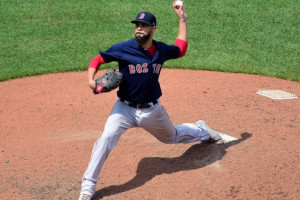
Starting pitching in the postseason is a completely different animal than the regular season. With the magnitude of importance that every game, every inning, and perhaps every out carries, starters are given much shorter leashes in October. There’s no other position in any other sport you can even compare it to. In other sports, you expect teams to go with what got them there. Quarterbacks don’t get pulled from NFL playoff games at the first sign of trouble. The bullpen is going to play a much bigger role in order, mixing and matching earlier to create optimal matchups much sooner than normally during the season.
In one way, it is a little bit like other sports though. During the regular season, you’re projecting performance. You already pretty much know the opportunity that’s going to be presented once the lineup card is out. In football (and basketball, though I don’t play), you’re often trying to project opportunity and think along with the coach. In essence, you’re doing the same thing with starting pitching in October.
This two-part series will take a look at both the American League and later the National League pitching staffs in the postseason, previewing the projected starting pitchers and the matchups, while also taking some educated guesses about managerial tendencies to see if we can figure out which managers may go quickly to the bullpen and who might let their starters linger out there longer.
Texas vs Toronto
This is not going to be the series you’ll likely want your post-season daily fantasy pitching to come from most days. You have the top offense in the league in just about every area, two positive run environments, and several low upside pitchers.
Park Factors (3 year overall run factor via Seamheads.org and 2015 only via ESPN)
Rangers Ballpark in Arlington (Globe Life Park) = 1.08 (S), 1.14 (E)
Rogers Centre in Toronto = 1.05 (S), 0.91 (E)
Texas Rangers
Opponent
Vs LHP 124 wRC+ (1st), 17.6 K%, 14.7 HR/FB (1st), 15.4 Hard-Soft%
Vs RHP 115 wRC+ (1st), 18.7 K%, 15.2 HR/FB (2nd), 19.3 Hard-Soft%
Home 125 wRC+ (1st), 17.3 K%, 15.7 HR/FB (3rd), 18.5 Hard-Soft%
Road 109 wRC+ (1st), 19.6 K%, 14.3 HR/FB (1st), 19.3 Hard-Soft%
The Rangers were expected to finish at or near the bottom of their division, especially after losing Yu Darvish before the season even began, but huge healthy bounce back seasons by Shin-Soo Choo and Prince Fielder propelled them to a division title. Honestly, with a team 96 wRC+ and 4.25 ERA, I’m not how sure they did it, but Fangraphs gives them a 19.1 BsR, well ahead of any other team. So base-running must be how they won the division.
Unfortunately, they face the most lethal offense in baseball under any circumstances, but most dangerous against LHP, which, again, the Rangers have a lot of. As of this writing, only Games One (Yovani Gallardo) & Two (Cole Hamels) have been announced, but the Rangers will be forced to throw two of Derek Holland (a lefty), Martin Perez (another lefty), and/or Colby Lewis (bad) unless they come back with Gallardo on short rest, which may be the better solution. There are very few factors (like maybe Toronto doesn’t show up?) that might tempt you to use Texas pitcher this weekend.
Projected Starters
Yovani Gallardo a right-handed ground ball pitcher (49.3 GB%) with a 3.42 ERA might be their best real world hope of winning Game One, but career lows in K% (15.3), SwStr% (6.5), and K-BB% (6.7) along with a FIP (4.00), xFIP (4.25), and SIERA (4.59) all at least a half a run higher than his ERA give him very little value in a daily fantasy setting. In fact, his 6.7 K-BB% is nearly half his 12.8% career rate, which was merely league average to begin with. His 8.8 HR/FB is also suspect, as it was his lowest mark in five years (career 11.0 HR/FB). If you’re looking at his ERA and thinking of rostering Gallardo, you’re praying the Blue Jays hit a ton of ground balls right at people. It’s not an advisable action to take.
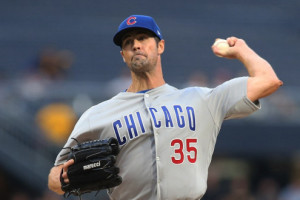
Cole Hamels is the best of the bunch, but through 83.2 innings in a Ranger uniform, he was more good than great (3.66 ERA with similar estimators and a 16.0 K-BB%) and is often priced as an Ace in the daily fantasy world. The one thing he has consistently done since the trade is pitch deep into games, going at least six innings in all 12 starts and at least seven in seven of them. He has occasionally struggled with walks and HRs since the trade, but has also been brilliant in several starts. He’s struck out at least eight in six of his starts, including three of his last four, but also fewer than five four times. You just can’t be sure what you’re going to get from game to game with Hamels and it will generally cost quite a bit to find out. The one good thing is that he doesn’t seem to have much of a split and has even been slightly better vs RHBs throughout his career with a .294 wOBA vs righties both this year and for his career. In the end, he is still a left-handed pitcher facing the Blue Jays in Toronto.
Derek Holland pitched 58.2 innings with a 4.91 ERA (5.30 FIP) and 16.7 K% (6.9 SwStr%). He allowed 11 HRs in 10 starts with a 20.3 Hard-Soft%. On second thought, maybe he is the odd man out here. This is a very dangerous profile to take against any major league team, especially the Blue Jays. He allowed at least three ERs in each of his last five starts with more walks than strikeouts in three of them.
Martin Perez might be the better choice if you have to throw another lefty against the Blue Jays. His 14.2 K% is nearly non-existent, though his 7.5 SwStr% was a little less terrible. He allowed just three HRs in 78.2 IP, due to an impressive 59.9 GB% that was 7th in baseball among those with at least 70 innings. He combined that with a measly 2.3 Hard-Soft% for a 3.40 FIP that was a run below his 4.46 ERA via a .324 BABIP and 62.8 LOB%. While he may have deserved better results and his profile may fare better than Holland’s here, he dominated lefties (27.5 K%, 71.4 GB%, -23.3 Hard-Soft%) and was more average vs righties (10.7 K%, 57.7 GB%, 7.2 Hard-Soft%), meaning he too, is likely to struggle in such a horrendous spot.
Colby Lewis allowed two ERs or less in 15 of his 33 starts this year and was the only Texas pitcher to reach 200 innings. He also allowed at least four ERs 11 times, including five of his last eight, while allowing 26 HRs with a 19.2 Hard-Soft%. He is an extreme fly ball pitcher (44.2%) with just a 16.5 K%. His ERA and estimators were all well over four.
Managerial Tendencies
Jeff Banister is a first-year manager who we don’t have much information about. He spent a lot of time in the Pittsburgh organization until last season and we do know that they are at the forefront of the analytic movement and communicate their ideas well from the front office to field management, so perhaps that’s rubbed off on him and we can expect him to be aggressive with his bullpen. Perhaps he’ll also likely have no choice in taking a weak starting staff against the best offense in baseball. Cole Hamels did pitch a complete game on the final day of the season, so he’s likely the one guy who will get the benefit of the doubt here. I’d expect quick hooks and little leeway beyond that though, especially if the Rangers trail in the series, as you’d think they would.
Toronto Blue Jays
Opponent
Vs LHP 96 wRC+, 21.6 K%, 12.9 HR/FB, 12.1 Hard-Soft%
Vs RHP 97 wRC+, 19.0 K%, 10.7 HR/FB (2nd), 10.1 Hard-Soft%
Home 103 wRC+, 18.4 K%, 12.4 HR/FB, 13.4 Hard-Soft%
Road 89 wRC+, 21.4 K%, 10.6 HR/FB (1st), 18.2 Hard-Soft%
The Blue Jays just offensively mauled their way to a division title and first playoff appearance in 21 years, but picked up potential Cy Young award winner David Price along the way. This move and the unexpected early return of Marcus Stroman has solidified their rotation and pushed middle of the rotation pitchers back to the middle of the rotation for the postseason run. They face a Texas team that leans a bit more left-handed than right, but had nearly equal results, just below average against each. They were a poor road offense, but the positive run environments in both parks should give them a bit of a bump.
Projected Starters
David Price bolstered a very mediocre Toronto rotation with his arrival at the trade deadline. In just 74.1 innings (2.30 ERA, 2.22 FIP, 2.89 xFIP, 2.91 SIERA), he led the team in pitching fWAR (2.7) and it wasn’t even that close. He has an enormous 29.4 K% (12.9 SwStr%) and 23.3 K-BB% in his time in Toronto, allowing two ERs or less in eight of his 11 starts, striking out at least six in all of them with four total HRs, while going fewer than seven innings just twice. He did extremely well against hitters from both sides of the plate this year, actually striking out righties at a bit higher rate, but also allowing them to hit the ball harder, though with similar results. He’s one of very few pitchers in this series worth rostering and even paying up for.
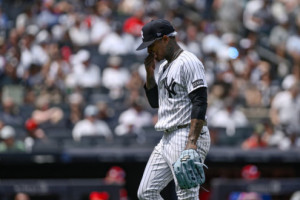
Marcus Stroman gets Game Two. He started four games after returning from a serious knee injury and while his 1.67 ERA was impressive, all of his estimators in the low to mid-threes belied a .237 BABIP and 90.9 LOB%. A 17.5 K% is less than he showed in his rookie season (20.8%) last year, but he did increase his strikeouts in each start, finishing with an eight strikeout effort (30 batters) in his final start. Much of the reason for his success was excellent contact management, combining an astounding 64.1 GB% with a -2.6 Hard-Soft%. While I wouldn’t expect him to sustain these rates over a full season, they’re a solid foundation to build on. Stroman is definitely a pitcher we can consider using at an average or lower price tag.
Marco Estrada road a career low 8.7 HR/FB and an absurd .216 BABIP to a 3.13 ERA that was well over a run below his ERA estimators. His 18.1 K% was well below his career rate (21.6%), but he did have an above average 9.9 SwStr%. Perhaps the biggest issue here will be an extreme fly ball rate (52.3%) against a team with some power in a fairly difficult environment. Due to his low ERA, Estrada may end up an over-priced, high-risk pitcher on most sites.
R.A. Dickey had a 3.91 ERA with estimators about a half run to a run higher and while knuckleballers don’t always conform to the normal sabermetric measures of most pitchers, his 14.3 K% was his lowest since before his Mets revival in 2010. He did maintain a near league average 9.1 SwStr% though. A .257 BABIP is the lowest mark of career, but is not much below his marks from the previous five years, all below .280. Dickey allowed two ERs or fewer in five of his last six starts, but struck out a total of 10 over his last four. Dickey may also end up being over-priced for the limited upside he gives you in contrast to the risk he carries.
Managerial Tendencies
It’s difficult to project what the postseason tendencies of manager John Gibbons will be. While David Price is likely to have a longer leash than most, what happens after that will likely be determined by the flow of the series. The bullpen was middle of the road overall (3.50 ERA, 3.56 xFIP) with Hendricks, Cecil, and Osuna all starring with a K rate above 27% and ERA below three. LaTroy Hawkins and Aaron Sanchez have been respectable too in relieving roles.
Houston vs Kansas City
Houston beat the Yankees on the road in the AL Wild Card game to earn a division series berth, costing them the ability to throw a potential Cy Young award winner twice in this series. The Royals had a much easier path through the regular season with the Tigers and White Sox underperforming, providing a cushion as the Royals basically ran away with the division with the best record in the American League. Offensively, it’s an interesting and stark contrast of styles between a team that sacrifices some contact for a lot of power and another that sacrifices power for contact and rarely strikes out.
Park Factors (3 year overall run factor via Seamheads.org and 2015 only via ESPN)
Minute Maid Park in Houston = 1.01 (S), 0.93 (E)
Kauffman Stadium in Kansas City = 1.04 (S), 1.02 (E)
Houston Astros
Opponent
Vs LHP 98 wRC+, 15.1 K% (30th), 7.8 HR/FB (30th), 9.7 Hard-Soft%
Vs RHP 100 wRC+, 16.3 K% (30th), 9.4 HR/FB (28th), 8.9 Hard-Soft%
Home 106 wRC+, 14.8 K% (30th), 8.2 HR/FB (28th), 10.9 Hard-Soft%
Road 93 wRC+, 17.0 K% (30th), 9.5 HR/FB, 7.6 Hard-Soft%
Houston is at a disadvantage in that they are only going to be able to throw their #1 guy once in the series, but when you consider that he’s probably better suited than others to pitch at home, maybe it’s not such a terrible thing. They have a couple of solid starters behind him and a rental who struggled ab it down the stretch. The Royals have a balanced lineup of lefties and righties whom mostly play every day without platoons and while they don’t present much of a problem in terms of power or hitting the ball really hard, they are difficult to roster pitchers against in daily fantasy due to their strikeout rate, by far the lowest in the league against pitchers from either side.
Projected Starters
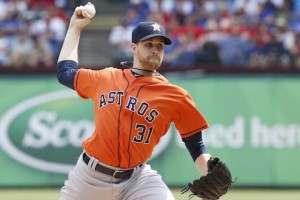
Collin McHugh was unable to duplicate his 2014 success, but had a similar SwStr rate that did not show up in a reduced K% early on and also saw a 51 point rise from an unrealistic .259 BABIP last year. The strikeout rate caught up though as he had a 23.3 K% (16.6 K-BB%) with a 2.89 ERA (2.81 FIP, 3.53 xFIP) over his final 11 starts, allowing more than two ERs only three times (though all three came in his last five starts). Kansas City could cause some issues with his strikeout rate, as it will all Houston pitchers, but at a reasonable price he could still be startable (at least in Game One) in either park with a 1.31 GB/FB and impressive 3.4 Hard-Soft% to go along with some ability to miss bats. It’s just been confirmed by Rotoworld as I write this that he’ll get Game One.
Scott Kazmir could be the odd man out after crawling to the finish line for the second consecutive year, but if he does get a start, I would speculate it would be in Game Two in Kansas City as HRs were a huge problem for him after being traded. He allowed 15 of his 20 HRs in just 13 starts with the Astros and allowing more fly balls than grounders. Overall, he had a 4.17 ERA, 5.19 FIP, and 4.86 xFIP with just a 9.3 K-BB% for Houston.
Mike Fiers did much better than Kazmir with a 15.4 K-BB% and 2.67 ERA in 10 starts for Houston, but also a .199 BABIP, 83.3 LOB%, and 4.32 FIP/3.98 xFIP. An extreme fly ball pitcher (42.1%), he is better suited to pitching in Kansas City (if Kazmir doesn’t) and also struggled with HRs down the stretch (eight over his last five starts). He may be in consideration at the right price on the road in this series, but is a much riskier play in a more power-friendly home park and may be subject to a short leash (as will the rest of the rotation) that I’ll cover more in the managerial tendencies section.
Dallas Keuchel was second in baseball with a 61.7 GB% and allowed less hard contact (21.2%) than any pitcher in the majors while inducing the third-most frequent soft contact (25.2%). Combine all those weak ground balls with a 23.7 K% (18.1 K-BB%) and you end up with a stud and Cy Young contender. He is also the most tailored to pitch at home because of that ground ball rate and in fact, he dominated in Houston with a 22.4 K-BB%, 2.04 FIP, and 2.20 xFIP next to a 1.46 ERA. Even with the risk of a reduced strikeout rate, Keuchel will be a usable if not desirable pitching target if the cost isn’t too exorbitant.
Lance McCullers should get Game Four with McHugh announced for Game One and the other two more suited for a road start. While not an extreme ground ball pitcher, he did have a respectable 1.46 GB/FB combined with an impressive 24.8 K% in his rookie season. He did occasionally struggle with control (8.3 BB%) and also allowed five HRs over his last four starts. He too can be used if the price is not too high, but with late season struggles and a strong bullpen behind him in such an important game, I’d be concerned about his leash.
Managerial Tendencies
A.J. Hinch may be a first-year manager, but this shouldn’t but this shouldn’t be too difficult to figure out considering well-known organizational philosophies and a hard sabermetric slant. The Houston leadership is definitely a progressive, new school thinking bunch and their bullpen was a major strength this year despite having few names most baseball fans would even recognize. They were third in K rate (24.8%) and FIP (3.38) and second in xFIP (3.50). They no doubt understand the times through the order penalty even the best pitchers suffer as the game moves along and will likely go to the bullpen early and often if necessary, especially as all starters except McHugh allowed at least five HRs over the last month of the season. In fact, I’d boldly venture that starters don’t go more than two times through the lineup under most circumstances even if they’re pitching well. Keuchel may be the exception here as he’s earned the biggest leash and we may have seen a preview of their intentions with him as he was allowed to face Alex Rodriguez in a tough spot to get out of the 6th inning of the Wild Card game. Whichever starter moves to the bullpen may further strengthen it if their stuff can play up in shorter spurts.
Kansas City Royals
The Royals don’t have a dominant strikeout pitcher on the front lines and seem to have gotten less than they bargained for with Johnny Cueto, but it’s a far cry running Jason Vargas and Jeremy Guthrie out there 40% of the time. They use speed and defense, along with a big park (though a positive run scoring environment) to enhance their pitching and hide some of their shortcomings. The Astros have a lot of power, but will strike out often vs RHP (which is what Kansas City will throw at them), which makes them very scary at home, but more vulnerable on the road in a big park.
Opponent
Vs LHP 105 wRC+, 21.6 K%, 14.3 HR/FB (3rd), 13.5 Hard-Soft%
Vs RHP 104 wRC+ (3rd), 23.6 K% (2nd), 14.9 HR/FB (3rd), 9.6 Hard-Soft%
Home 112 wRC+ (2nd), 23.6 K% (2nd), 17.8 HR/FB (1st), 18.5 Hard-Soft%
Road 98 wRC+, 22.3 K%, 12.1 HR/FB, 14.0 Hard-Soft%
Projected Starters
Yordano Ventura pushed his K rate to an above average 22.5% with a 10.5 SwStr% en route to a 4.08 ERA that was about a half run higher than his estimators. Walks and HRs were occasionally a problem, but he allowed just five of his 14 round trippers at home. He finished the season allowing one ER in 14 innings with 17 strikeouts over his last two starts. Against a team with a 23.6 K% vs RHP, he’s an interesting option at home, though we have to note that with a strong bullpen and consideration of bringing him back in Game Four if necessary, he may not get more than six innings even on a good day.
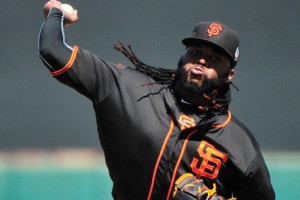
Johnny Cueto had a 4.76 ERA and 16.0 K% with ERA estimators a bit lower, but still above four in 13 starts after being traded. Most people thought he would excel in a bigger park with the best defense in baseball behind him, but the truth is he already had a pretty good defense in Cincinnati and his BABIP went up 100 points after he left. While he didn’t allow more than three ERs in any of his last four starts, he finished with just six strikeouts against six walks over his last two. I went into this thinking I was going to be able to recommend him at home against a high strikeout team as a late season rebound project with a strong track record, but now I don’t really know. I’m not sure I’d trust him for more than an average price tag and expect that he’s worked himself out of being above the bullpen treatment. In other words, six mediocre innings and out most likely outcome here even on the optimistic side.
Edinson Volquez actually had decent road numbers and a higher 20.0 K% in his away games, but also a more normalized 9.4 HR/FB with an 8.7 BB%. Put a 17.8 HR/FB at home for the Astros up against that walk rate and rostering him could very quickly ruin your daily fantasy night.
Game four doesn’t seem to be confirmed yet. It might be Chris Young ahead of Danny Duffy and Kris Medlen if they are up, but it’s being speculated that Ventura could come back on short rest in an elimination game. Duffy out of the bullpen could be interesting if his stuff plays up in short bursts and could make that pen that much deeper and dangerous.
Chris Young has been a success story for the Royals with a 3.02 ERA and has always beaten his peripherals, but never by the run and a half to two runs he’s done so by this year, while depending greatly on his defense and a .209 BABIP. An extreme fly ball pitcher (57.9%) with a 16.6 K% in a power-friendly park is not what you’re looking for in a daily fantasy pitcher.
Managerial Tendencies
While losing a pitcher of Greg Holland’s caliber is a significant blow to any team, it’s perhaps less of one when you have a guy like Wade Davis (0.94 ERA, 31.1 K%) in reserve. Add a rejuvenated Ryan Madson (.213, 23.4 K%) to the mix and although Kelvin Herrera hasn’t been as good this year, they are still looking to shorten the game and getting it to a deep bullpen with a dominant back end. They will be looking for six innings out of their starters and while Ned Yost has made progress with a more modern thought process, he can still be stubborn about some of that old school mentality occasionally, so we may see a little more leniency with struggles earlier in the first few games.